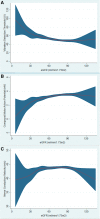Chronic kidney disease and peripheral nerve function in the Health, Aging and Body Composition Study
- PMID: 29757410
- PMCID: PMC6452189
- DOI: 10.1093/ndt/gfy102
Chronic kidney disease and peripheral nerve function in the Health, Aging and Body Composition Study
Abstract
Background: Chronic kidney disease (CKD) is associated with poor mobility. Peripheral nerve function alterations play a significant role in low mobility. We tested the hypothesis that early CKD is associated with altered sensory, motor and autonomic nerve function.
Methods: Participants in the Health, Aging and Body Composition cohort who had kidney function measures in Year 3 (1999-2000) and nerve function measurements at Year 4 (2000-01) were analyzed (n = 2290). Sensory (vibration threshold, monofilament insensitivity to light and standard touch), motor [compound motor action potentials (CMAPs), nerve conduction velocities (NCVs)] and autonomic (heart rate response and recovery after a 400-m walk test) nerve function as well as participant characteristics were compared across cystatin C- and creatinine-based estimated glomerular filtration rate categorized as ≤60 (CKD) or >60 mL/min/1.73 m2 (non-CKD). The association between CKD and nerve function was examined with logistic regression adjusted for covariates.
Results: Participants with CKD (n = 476) were older (77 ± 3 versus 75 ± 3 years; P < 0.05) and had a higher prevalence of diabetes (20.6% versus 13.1%; P < 0.001). CKD was associated with higher odds for vibration detection threshold {odds ratio [OR] 1.7 [95% confidence interval (CI) 1.1-2.7]} and light touch insensitivity [OR 1.4 (95% CI 1.1-1.7)]. CMAPs and NCVs were not significantly different between CKD and non-CKD patients. In adjusted analyses, participants with CKD had higher odds of an abnormal heart rate response [OR 1.6 (95% CI 1.1-2.2)] and poor heart rate recovery [OR 1.5 (95% CI 1.1-2.0)].
Conclusions: CKD is associated with changes in sensory and autonomic nerve function, even after adjustment for demographics and comorbidities, including diabetes. Longitudinal studies in CKD are needed to determine the contribution of nerve impairments to clinically important outcomes.
Keywords: chronic kidney disease; motor; peripheral nerve; sensory.
© The Author(s) 2018. Published by Oxford University Press on behalf of ERA-EDTA. All rights reserved.
Figures
Similar articles
-
Chronic kidney disease as a risk factor for peripheral nerve impairment in older adults: A longitudinal analysis of Health, Aging and Body Composition (Health ABC) study.PLoS One. 2020 Dec 15;15(12):e0242406. doi: 10.1371/journal.pone.0242406. eCollection 2020. PLoS One. 2020. PMID: 33320861 Free PMC article.
-
Chronic kidney disease defined by cystatin C predicts mobility disability and changes in gait speed: the Framingham Offspring Study.J Gerontol A Biol Sci Med Sci. 2014 Mar;69(3):301-7. doi: 10.1093/gerona/glt096. Epub 2013 Aug 2. J Gerontol A Biol Sci Med Sci. 2014. PMID: 23913929 Free PMC article.
-
Examining the utility of cystatin C as a confirmatory test of chronic kidney disease across the age range in middle-aged and older community-dwelling adults.J Epidemiol Community Health. 2018 Apr;72(4):287-293. doi: 10.1136/jech-2017-209864. Epub 2018 Jan 13. J Epidemiol Community Health. 2018. PMID: 29332011
-
Prevalence of chronic kidney diseases in patients with chronic obstructive pulmonary disease: assessment based on glomerular filtration rate estimated from creatinine and cystatin C levels.Int J Chron Obstruct Pulmon Dis. 2015 Jul 6;10:1283-9. doi: 10.2147/COPD.S80673. eCollection 2015. Int J Chron Obstruct Pulmon Dis. 2015. PMID: 26185434 Free PMC article.
-
Mobility-Related Consequences of Reduced Lower-Extremity Peripheral Nerve Function with Age: A Systematic Review.Aging Dis. 2015 Nov 27;7(4):466-78. doi: 10.14336/AD.2015.1127. eCollection 2016 Aug. Aging Dis. 2015. PMID: 27493833 Free PMC article. Review.
Cited by
-
Step length and fall risk in adults with chronic kidney disease: a pilot study.BMC Nephrol. 2022 Feb 22;23(1):74. doi: 10.1186/s12882-022-02706-w. BMC Nephrol. 2022. PMID: 35193493 Free PMC article.
-
Multiparametric quantitative magnetic resonance imaging of skeletal muscle in CKD.Am J Physiol Renal Physiol. 2025 Jul 1;329(1):F99-F111. doi: 10.1152/ajprenal.00254.2024. Epub 2025 May 27. Am J Physiol Renal Physiol. 2025. PMID: 40421837 Free PMC article.
-
Renal hemodynamic dysfunction and neuropathy in longstanding type 1 diabetes: Results from the Canadian study of longevity in type 1 diabetes.J Diabetes Complications. 2022 Nov;36(11):108320. doi: 10.1016/j.jdiacomp.2022.108320. Epub 2022 Sep 28. J Diabetes Complications. 2022. PMID: 36201892 Free PMC article.
-
Associations of Lower Extremity Peripheral Nerve Impairment and Risk of Dementia in Black and White Older Adults.Neurology. 2022 May 3;98(18):e1837-e1845. doi: 10.1212/WNL.0000000000200185. Epub 2022 Mar 9. Neurology. 2022. PMID: 35264428 Free PMC article.
-
Association of HbA1c Variability with Vibrating Perception Threshold in Middle-Aged and Elderly Patients with Type 2 Diabetes Mellitus: A Retrospective Cohort Study.Diabetes Metab Syndr Obes. 2024 Jan 10;17:193-202. doi: 10.2147/DMSO.S443917. eCollection 2024. Diabetes Metab Syndr Obes. 2024. PMID: 38225978 Free PMC article.
References
-
- Kooman JP, Broers NJ, Usvyat L. et al. Out of control: accelerated aging in uremia. Nephrol Dial Transplant 2013; 28: 48–54 - PubMed
-
- Painter P, Roshanravan B.. The association of physical activity and physical function with clinical outcomes in adults with chronic kidney disease. Curr Opin Nephrol Hypertens 2013; 22: 615–623 - PubMed
-
- McDermott MM, Guralnik JM, Albay M. et al. Impairments of muscles and nerves associated with peripheral arterial disease and their relationship with lower extremity functioning: the InCHIANTI Study. J Am Geriatr Soc 2004; 52: 405–410 - PubMed
Publication types
MeSH terms
Substances
Grants and funding
LinkOut - more resources
Full Text Sources
Other Literature Sources
Medical
Miscellaneous


